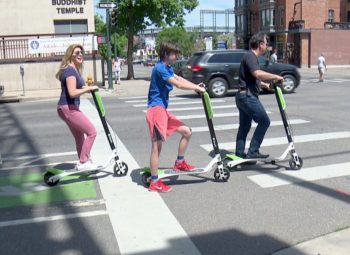
Its rival Lime claims the vehicles “reduce dependence on personal automobiles for short-distance transportation and leave future generations with a cleaner, healthier planet.”
But the mere fact that battery-powered scooters don’t belch pollution out of a tailpipe doesn’t mean they’re “emissions-free,” or as “eco-friendly” as some have assumed.
The actual climate impact of the vehicles depends heavily on how they’re made, what they’re replacing, and how long they last.
Researchers at North Carolina State University decided to conduct a “life-cycle assessment” that tallied up the emissions from making, shipping, charging, collecting, and disposing of scooters after one of them noticed that a Lime receipt stated, “Your ride was carbon-free.”
The study concludes that dockless scooters generally produce more greenhouse-gas emissions per passenger mile than a standard diesel bus with high ridership, an electric moped, an electric bicycle, a bicycle—or, of course, a walk.
The paper found that scooters do produce about half the emissions of a standard automobile, at around 200 grams of carbon dioxide per mile compared with nearly 415.
But, crucially, the researchers found in a survey of e-scooter riders in Raleigh, North Carolina, that only 34% would have otherwise used a personal car or ride-sharing service.
Nearly half would have biked or walked, 11% would have taken the bus, and 7% would have simply skipped the trip.
The bottom line: roughly two-thirds of the time, scooter rides generate more greenhouse-gas emissions than the alternative.
And those increased emissions were greater than the gains from the car rides not taken, says Jeremiah Johnson, an engineering professor and one of the authors of the paper.
The electricity used to charge the vehicles is one of the smallest contributors to the product’s emissions.
Fully half come from the raw materials and manufacturing process, which the researchers estimated, in part, by disassembling a Chinese-made Xiaomi M365 scooter, a model that Lime and Bird are known to use.
The team weighed each part, including the aluminum frame, steel parts, lithium-ion battery, and electric motor.
They then relied upon the findings of earlier peer-reviewed studies to assess the environmental impacts of extracting, producing, and delivering those raw materials.
But how much these emissions add up to on a per-mile basis depends heavily on how long scooters actually last.
An increasingly evident problem is that the vehicles’ theoretical operating life of around two years scarcely resembles their “nasty, brutish and often short” existence in the real world.
Scooters are variously flung into water bodies, tossed from buildings, set on fire, run over, and used in stunts. Cleanup crews in Oakland, California, fished 60 scooters out of Lake Merritt in a single month last year, Slate reported.
An analysis of open data from Bird’s inaugural fleet in Louisville, Kentucky, conducted by Quartz last year, found that the average scooter lasted just 28.8 days.
Likewise, Bird itself acknowledged in investor documents at an earlier point that its vehicles last only about a month or two, The Information reported.
The other major share of emissions, 43%, comes from the additional fleet of vehicles needed to navigate around a city like Raleigh each day, collecting scooters strewn across yards and sidewalks, taking them to a central charging location, and returning them to spots where riders can find them. …snip…
The North Carolina findings are, however, consistent with some earlier efforts to evaluate life-cycle emissions or usage patterns.
Read rest at MIT Technology Review



















Inadvertently these e=riders are helping mother earth with more CO2.
They are “greening” the earth.
Like the Nit-Wit who say we should dump our cars and ride a bicycle but lets see these idiots get a months worth of groceries from the store to their home on a bicycle even if a large family carrying bags of groceries would take a while and it would.nt be safe
One of my relatives bought one of the early VW diesel Rabbit’s. He ran the odometer to several hundred thousand miles, and VW used his Rabbit in an advertisement. Economical?
He lived 50 miles from his job.
12 hours a week commuting!
This story brings to mind the local news story in Baltimore about 15 years ago of a family of 4 who sold their car and in its place they bought four small motorcycles. The story focussed on the gas savings and reduced pollutions output since a small motorcycle gets about 70 miles per gallon, so they family was following the belief that they were several factors ahead of the game on cost and environmental impact. Did nobody follow the logic or the math that four motorcycles running simultaneously at 70 mpg really means a collective fuel economy of only 17.5mpg? Isupposed that someone eventually did so and felt really embarrassed about going public with this silly story.
What a surprise that a bunch of millenials mistreat something that they don’t own! Shocked that the scooters make it even two months before they are no longer usable.
I remember a one – liner from the ’70’s , “you can cram more compact cars into a traffic jam”
It’s not the vehicle that makes a difference, it’s your driving habits.